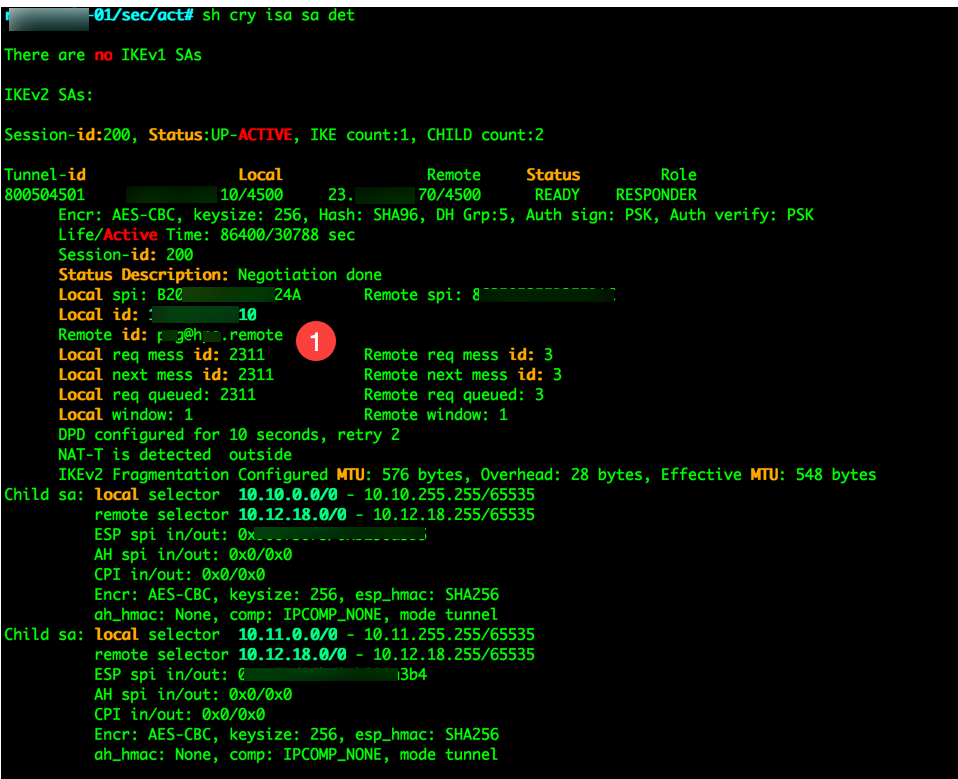Have you ever ordered a bunch of Fortinet gear... Full Story
By Manny Fernandez
September 1, 2018

IKEv2 Dynamic Remote Fortigate to Head-In ASA
Customer had a Cisco ASA 5516-X that we used to replace aging 5510’s. I told the customer that we would ONLY do IKEv2 on this set of firewalls as I did not want to put old technology on a “new” platform. Customer was running EZ-VPN on 5510 and wanted to replace their End-of-Life ASA 5505. Customer purchased 6 Fortigate 50Es for the remotes as a starting point. These firewalls were behind NAT’d devices inside hospitals around the country.
In the past, when the customer had ASA 5505s at the remote sites, the only way to connect to them was when traffic was initiated from the 5505 to the main site. This was a problem sometimes. With the new Fortigate, this problem was solved. Using FortiCloud, the firewalls build a management tunnel to the Forticloud environment upon connecting to an Internet connection. You can then log into the FortiCloud Portal and ride that management tunnel back to the Fortigate to manage it.
This configuration CAN be done entirely via the GUI, however I decided to do this one via the CLI.
Here goes it:
config firewall address edit "LOCAL-LAN" set color 18 set subnet 10.12.18.0 255.255.255.0 next edit "REMOTE-LAN-01" set color 18 set allow-routing enable set subnet 10.11.0.0 255.255.0.0 next edit "REMOTE-LAN-02" set color 18 set allow-routing enable set subnet 10.10.0.0 255.255.0.0 next end
This creates the address objects I will use as the Phase II selectors in the VPN.
config vpn ipsec phase1-interface edit "HEAD-IN" set interface "wan1" set ike-version 2 set peertype any set proposal aes256-sha1 set localid "[email protected]" set remote-gw 1.1.1.1 set psksecret %Pre-Shared-Key-Here% next end
Here we can see the creation of the Phase I of the VPN. We can see that it is using IKE v2. The real information has been changed to protect the guilty 🙂
config vpn ipsec phase2-interface edit "18 to 10.11" set phase1name "HEAD-IN" set proposal aes256-sha256 set src-addr-type name set dst-addr-type name set src-name "LOCAL-LAN" set dst-name "REMOTE-LAN-01" next edit "18 to 10.10" set phase1name "HEAD-IN" set proposal aes256-sha256 set src-addr-type name set dst-addr-type name set src-name "LOCAL-LAN" set dst-name "REMOTE-LAN-02" next end
Here you can see the Phase II selectors we are going to use. We can see that we are using AES-256 with a SHA-256 hash. We can also see we used ‘src-name’ to choose the address object we created earlier.
config firewall policy edit 4 set name "VPN 18 to RAM" set srcintf "lan" set dstintf "HEAD-IN" set srcaddr "LOCAL-LAN" set dstaddr "REMOTE-LAN-01" "REMOTE-LAN-02" set action accept set schedule "always" set service "ALL" set global-label "VPN Policies" next edit 5 set name "VPN RAM to 18" set srcintf "HEAD-IN" set dstintf "lan" set srcaddr "REMOTE-LAN-01" "REMOTE-LAN-02" set dstaddr "LOCAL-LAN" set action accept set schedule "always" set service "ALL" next end Now we created the Policies or rules (depending on firewall platform you learned on… I still say rules because I started in Checkpoint back on AIX).
config router static edit 3 set device "HEAD-IN" set dstaddr "REMOTE-LAN-01" next edit 4 set device "HEAD-IN" set dstaddr "REMOTE-LAN-02" next edit 5 set distance 240 set blackhole enable set dstaddr "REMOTE-LAN-01" next edit 6 set distance 240 set blackhole enable set dstaddr "REMOTE-LAN-02" next end
We also created the static route since the Fortigate is based on ‘route-based VPNs’ (Although you CAN do Policy Based as well).
NOW FOR THE CISCO SIDE
Since this is the head-in device, the config is NOT as complex.
We need to create the object and object-groups that will be used in the Access-List and NATs
object-group network remoet-local network-object 10.10.0.0 255.255.0.0 network-object 10.11.0.0 255.255.0.0 object network remote subnet 10.12.18.0 255.255.255.0
NOTE: Don’t be that guy/gal that uses the DM_INLINE objects through the GUI 🙁
crypto ipsec ikev2 ipsec-proposal AES256-SHA256 protocol esp encryption aes-256 protocol esp integrity sha-256
Here we have the Phase II Transform Sets. We can see that they match the previous one on the Fortigates.
crypto dynamic-map DYNAMIC-MAP 65200 set pfs group14 crypto dynamic-map DYNAMIC-MAP 65200 set ikev2 ipsec-proposal AES256-SHA256
We created a dynamic crypto-map that will be bound to the existing crypto-map. We can see it is using PFS for phase II (It is the default on the Fortigate so no need to configure it).
crypto map outside-map 65535 ipsec-isakmp dynamic DYNAMIC-MAP crypto map outside-map interface outside
Here we see the original crypto-map on the ASA (second line) and the dynamic crypto-map being bound to ‘outside-map’.
crypto ikev2 policy 2 encryption aes-256 integrity sha256 group 21 prf sha256 lifetime seconds 86400
Here is the Phase I IKEv2 profile
tunnel-group [email protected] type ipsec-l2l tunnel-group [email protected] general-attributes default-group-policy gp-remote-site tunnel-group [email protected] ipsec-attributes ikev2 remote-authentication pre-shared-key %Pre-Shared-Key-Here% ikev2 local-authentication pre-shared-key %Pre-Shared-Key-Here%
This section sets the pre-shared key and the group-policy to be used.
group-policy gp-remote-site internal group-policy gp-remote-site attributes vpn-tunnel-protocol ikev2
Group Policy called by the tunnel-group
Once the remote connections senses traffic, it will initiate the VPN connection. To view it on the ASA side, run the following command
show crypto isa sa detail
You will have a similar output

In the output, I have blured out some real information icluding the remote ID which is marked with the ‘1’.
You are also going to have to define the access-list normally assigned to outside interface if you do not have the ‘sysopt’ enabled but you should not.
no sysopt connection permit-vpn
This will require that you define what you want to allow into or out of the ASA. You will also need a ‘no nat’ NAT statement
nat (inside,outside) source static remoet-local remoet-local destination static remote remote
Obviously you would want to have descriptive names for the site not ‘remote’ but you can use something like branch1-local and branch-1 remote respectively.
On the Fortigate, log into the GUI and go to ‘Monitor, IPSec Monitor’ or you can run the following command:
get vpn ipse tun sum
Hope this helps you out.
Recent posts
-

-

Had a customer with over 200 static routes on... Full Story
-

This is a work in progress, I will be... Full Story
